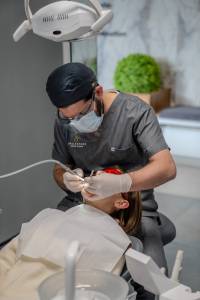Introduction: Wisdom teeth, or third molars, are often the last to join your dental ensemble, typically making their appearance in your late teens or early twenties. While they can be a valuable asset to your mouth when healthy and properly aligned, more often than not, they are misaligned or problematic, necessitating removal. This blog post demystifies wisdom teeth extraction, outlining what you need to know to ensure a comfortable and informed dental journey.
Why Wisdom Teeth Cause Issues: Unlike our ancestors, modern humans often have smaller jaws, leaving insufficient room for these late bloomers. When wisdom teeth are misaligned, they may position themselves horizontally, be angled toward or away from the second molars, or be angled inward or outward. This misalignment can crowd or damage adjacent teeth, the jawbone, or nerves.
Signs You May Need Your Wisdom Teeth Removed:
- Pain and Irritation: As wisdom teeth erupt, they can cause pain and swelling. If you notice discomfort at the back of your mouth, it might be time to consult your dentist.
- Gum Inflammation: Swollen, red gums can signal the emergence of wisdom teeth, leading to difficulty cleaning and potential infection.
- Alignment Issues: For those with previously straightened teeth, emerging wisdom teeth can disrupt alignment, causing crowding or shifting.

The Extraction Process: Wisdom teeth extraction is a common procedure, often performed under local anesthesia, sedation, or general anesthesia. Your dentist or oral surgeon will make an incision in the gum tissue to expose the tooth and bone, remove any bone blocking access to the tooth root, divide the tooth into sections if it’s easier to remove in pieces, remove the tooth, clean the site of the removed tooth, stitch the wound to promote healing (if necessary), and place gauze over the extraction site to control bleeding and to help a blood clot form.
Recovery and Aftercare: Post-extraction, your recovery is paramount. Swelling and discomfort are normal in the first few days, and your dentist will prescribe medication to manage pain. Here are some aftercare tips to ensure a smooth recovery:
- Rest and avoid strenuous activities for a few days.
- Use ice packs to reduce swelling.
- Stick to soft foods like yogurt, pudding, and applesauce initially.
- Avoid smoking and using a straw, as these can impede healing.
- Follow your dentist’s instructions on oral hygiene to prevent infection.
Conclusion:While the thought of wisdom teeth extraction might seem daunting, understanding the why’s and how’s can ease your mind and prepare you for what lies ahead. Remember, this common procedure is a stepping stone to better oral health and comfort. If you suspect your wisdom teeth are making an unwelcome entrance, don’t hesitate to reach out to your dental care provider.
At Smilespark, your health and comfort are our utmost priorities. Our team is here to guide you through every step of your dental health journey, ensuring you’re informed, comfortable, and confident in your care choices. If you have questions about wisdom teeth extraction or wish to schedule a consultation, contact us today—your path to a healthier smile awaits!


